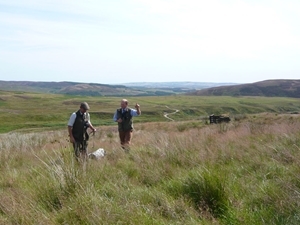Latest GWCT research reveals earliest recorded hatch date for red grouse – an indicator that other, less abundant species may be affected
 Researchers at the Game & Wildlife Conservation Trust Scotland have recorded the earliest ever hatch of a red grouse on its core count sites.
Researchers at the Game & Wildlife Conservation Trust Scotland have recorded the earliest ever hatch of a red grouse on its core count sites.
Following on from the publication of her scientific paper in 2013, which detailed an advance of grouse laying dates by 0.5 days per year, Dr Kathy Fletcher, head of the GWCT’s Scottish upland research, said her team has recorded the earliest nest found this year since the study began in 1992.
This two-decade-long research project has monitored the laying dates of red grouse using radio-tagged hens in Strathspey, and the conservation charity is continuing the work to establish the effect the warming springs will have on red grouse and other species.
“Although 2013 was quite a late year for grouse hatches, we have again seen an early year in 2014, which continues an overall earlier trend ,” said Dr Fletcher.
“The research shows grouse laying dates have advanced by 0.5 days per year. The gradual increase in spring temperatures and specifically warmer April temperatures has resulted in earlier laying by the grouse. Although warmer springs provide more plant food for the hens to get into good condition for breeding, warming in May and August may be less good for important food sources for the chicks. Although grouse were the only species monitored in this particular study, the climatic effects will also be relevant to other bird species, some of which are of conservation concern.
“So far grouse numbers have not been affected by the temperature range reported in this study, but it is important that we continue this kind of research and also expand it to other parts of the birds’ range.”
This essential work will directly feed into the management practices deployed by upland keepers and help determine timings and locations of work such as heather burning. Adaptive management is key to modern rural stewardship.
GWCT Director Scotland Dr Adam Smith said the early hatch dates may have implications for other species: “The research work undertaken by the GWCT is used by grouse moor managers to form future management plans, and it is vital that GWCT stays to the fore of this research and raises awareness of these environmental changes. Supporting the management of moors for grouse shooting is important as research shows that it is beneficial for a suite of other wildlife including wading birds, which are declining elsewhere, such as the globally near-threatened curlew.”
Notes to editors
The Game & Wildlife Conservation Trust is an independent wildlife conservation charity which carries out scientific research into Britain’s game and wildlife. We advise farmers and landowners on improving wildlife habitats. We employ 22 post-doctoral scientists and 50 other research staff with expertise in areas such as birds, insects, mammals, farming, fish and statistics. We undertake our own research as well as projects funded by contract and grant-aid from Government and private bodies. The Trust is also responsible for a number of Government Biodiversity Action Plan species and is lead partner for grey partridge and joint lead partner for brown hare and black grouse.
For information, contact:
Playfair Walker
Telephone: 0131 445 5570
Email: richard@playfairwalker.com